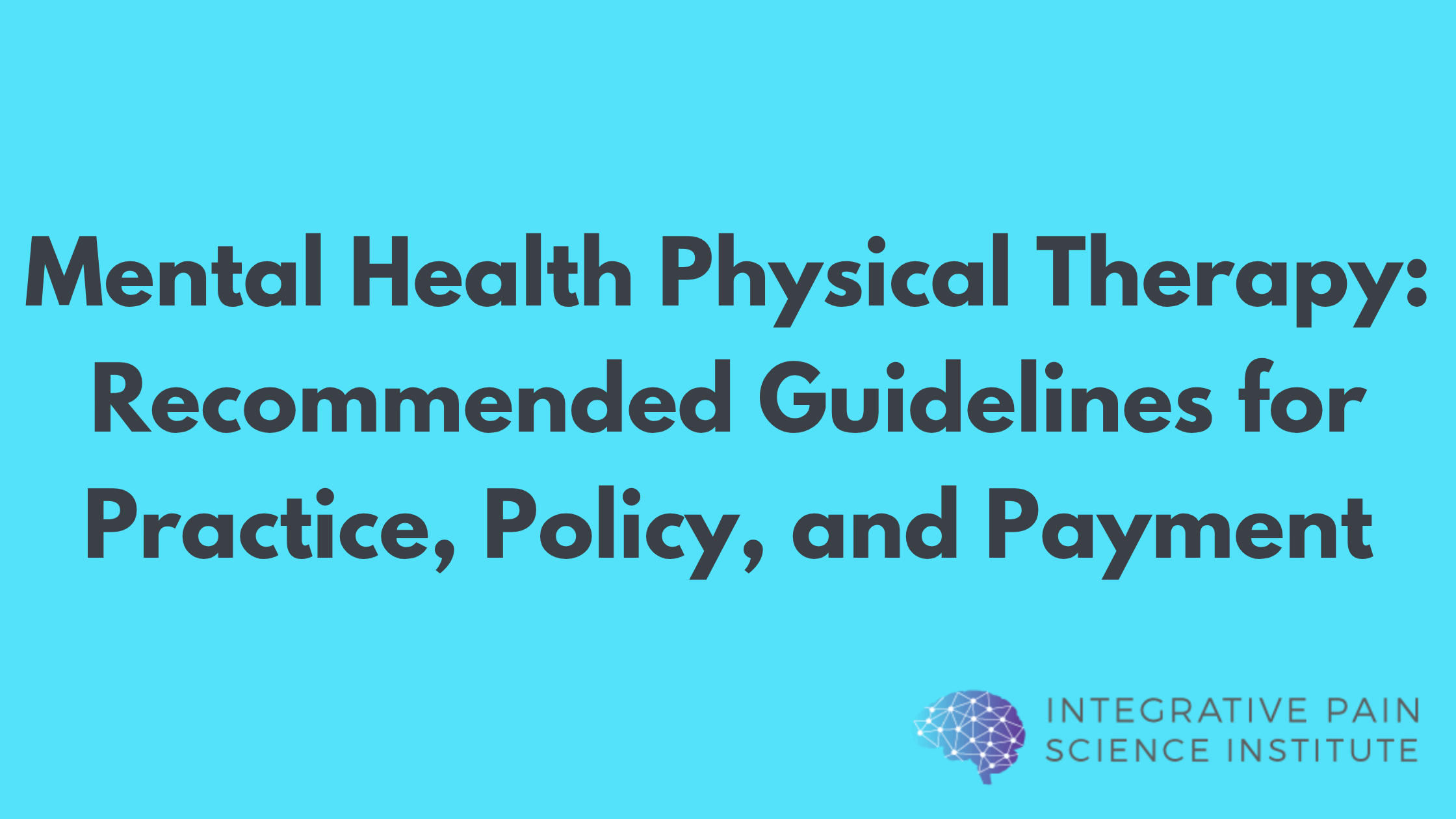Cognitive Behavioral Therapy (CBT) is a time-limited approach that has been shown to be effective across a number of chronic pain conditions. CBT involves a structured approach that focuses on the relationships among cognitions (thoughts), emotions, and behaviors. Treatments based on cognitive behavioral therapy have been successfully applied to chronic pain, either delivered alone, by a mental health provider, by a physical therapist, or as a component of an integrated, multimodal pain management program.
Research has shown physical therapists now recognize the importance of using cognitive behavioral techniques to help people with long-term chronic pain to lessen the struggle with fear-avoidance behaviors, as well as mild anxiety and depression. (1)
As we learn more about the importance of psychosocial factors among patients with persistent pain, modern pain practitioners are faced with the question of how best to address this concern when it arises in practice.
CBT involves a structured approach that focuses on the relationship among cognitions (or thoughts), emotions (or feelings), and behaviors. Share on XCaring for the Brain and the Body
Psychologically informed pain care addresses physical and psychosocial factors, by integrating cognitive-behavioral techniques into conventional physical therapy and other physical rehabilitation therapies. This can be applied with mindfulness, mindfulness-based stress reduction or by informing physical therapy practice with techniques adapted from cognitive behavioral therapy and acceptance and commitment therapy. The first step is recognizing psychological risk factors, known as “yellow flags.” (2) Once identified, psychologically sound cognitive-behavioral tools can be integrated into a patient’s treatment plan before maladaptive coping strategies take root.

7 Types of Cognitive Behavioral Skills for Pain
# 1: Mindful Movement
While movement may feel counterintuitive for patients, pain science shows time and again that “not moving is not a solution.” Fear of movement due to pain, termed kinesiophobia, is not only ineffective at decreasing pain, but it actually hinders progress by causing decreased stamina, decreased mobility, tightened muscles, muscle spasms, and increased weakness and fatigue. (3, 4) Helping clients understand the importance of physical activity and developing a plan that moves at a moderate pace will help ensure treatment adherence and patient success. Yoga, Tai-Chi, Qi Gong, Pilates, and Feldenkrais all couple mindfulness with movement to increase proprioceptive and interoceptive awareness.
Helping clients understand the importance of physical activity and developing a plan that moves at a moderate pace will help ensure treatment adherence and patient success. Share on X# 2: Relaxation Techniques
Patients with chronic pain often complain of tight muscles and stress. Deep breathing and guided imagery are two of the many available tools that can help invoke parasympathetic response, relaxing the body, calming the mind and establishing an overall sense of well-being. You might also recommend:
- Guided relaxation
- Progressive muscle relaxation
- Relaxation phone apps
- Relaxation paired with an activity
- Mantra recitation for positive affirmations
Go here for 5 Steps to Easing Pain with Guided Imagery.
# 3: Pleasant Activity Scheduling
Pleasant activity is used to control and decrease pain. Helping your patients identify activities that they enjoy is key to improving their quality of life. Not only do planned activities help boost mood and decrease anxiety through social engagement, but they also provide a powerful, healthy distraction. Pleasant activities can widen a patient’s world view about what is possible, helping to improve their self-efficacy and confidence.

# 4: Putting the Plan into Action
In this session, a plan of action can be determined that will outline a clear initiation of the aforementioned “pleasurable activities.” Your client may use time between sessions to consider some things they’d like to try, so that during this appointment, a more definite plan can be made that is both accessible and relevant. A “Pleasant Activity Schedule” can help the patient and therapist develop a plan for initiating the most valued activities in the upcoming week.
# 5: Cognitive Coping 1
Research shows that negative thoughts are directly associated with pain perception.(5) For example, catastrophizing can cause emotions that negatively impact mood and directly correspond to increased pain. In instances of chronic pain, negative thoughts can become the norm, automatically influencing a person’s mood and behavior, without them even realizing it. Educating patients on how negative thoughts can worsen their pain helps to prepare them for the self-observation that will be introduced in Step 6. You can hear more about how expectations shape pain in this podcast with Dr. Mark Bishop.
# 6: Cognitive Coping 2
Discuss with clients how to become aware of their thoughts throughout the day. Good examples of what to watch for are “all-or-nothing” thinking and always expecting the worst. Encourage them to notice the physical impact of negative thinking, such as stomach unease, lower back tension, or jaw clenching. Sometimes, saying one’s thoughts out loud can be enough to recognize their illegitimacy—and to dismiss them entirely! Invite your patients to discuss their fears and concerns. Noticing thoughts is the first step to challenging and replacing them, reassuring patients of the likelihood of more hopeful scenarios to come.

# 7: Sleep Education
Poor sleep is notorious among chronic pain patients and has been evidenced to cause low energy, irritability, decreased daily activities, poor performance, muscle tenderness, and more. (6) Consider discussing these positive sleep habits with your client:
- Using the bed only for sleep and sex
- Keeping a moderate room temperature (66 degrees)
- Shut down electronics at least one hour before bed
- Resist the urge to nap during the day
- No caffeinated beverages after 2 pm.
These 7 cognitive tools can have prolific health benefits for your clients. Recognizing yellow flags in your patients will give you the opportunity to broaden your therapeutic skills, and to include some psychologically sound measures that will support your patients in achieving optimum health.
Chronic pain affects many different areas within one’s life. The interaction between biomedical, psychological, and social influences helps to explain the variability between individuals and their reports of pain.
Are you confident in implementing psychologically sound tools into your clinical practice? Reach out to me on Facebook or leave a comment below. I would like to hear from you!
REFERENCES:
- Battalio SL, Glette M, Alschuler KN, et al. Anxiety, depression, and function in individuals with chronic physical conditions: a longitudinal analysis. Rehabil Psycho 2018 Oct 8. doi: 10.1037/rep0000231. [Epub ahead of print].
- Nicholas MK, Linton SJ, Watson PJ, et al.Early identification and management of psychological risk factors (“yellow flags”) in patients with low back pain: a reappraisal.Phys Ther 2011;91(5):737-53.
- Miller RP, Kori S, Todd D. The Tampa Scale: a measure of kinesiophogia. Clinical Journal of Pain 1991;7:51-52.
- Murphy JL, McKellar JD, Raffa SD, et al. Cognitive Behavior Therapy for Chronic Pain Among Veterans: Therapist Manual. Washington (DC): US Department of Veterans Affairs.
- Lawrence JM, Hoeft F, Sheau KE, et al. Strategy-dependent dissociation of the neural correlates involved in pain modulation. Anesthesiology 201;115(4):844-5.
- Turk DC, Meichenbaum D, Genest M. Pain and behavioral medicine: a cognitive-behavioral perspective. New York (NY): Guilford Press; 1983.
Dr. Tatta’s simple and effective pain assessment tools. Quickly and easily assess pain so you can develop actionable solutions in less time.
# 6: Cognitive Coping 2
Discuss with clients how to become aware of their thoughts throughout the day. Good examples of what to watch for are “all-or-nothing” thinking and always expecting the worst. Encourage them to notice the physical impact of negative thinking, such as stomach unease, lower back tension, or jaw clenching. Sometimes, saying one’s thoughts out loud can be enough to recognize their illegitimacy—and to dismiss them entirely! Invite your patients to discuss their fears and concerns. Noticing thoughts is the first step to challenging and replacing them, reassuring patients of the likelihood of more hopeful scenarios to come.

# 7: Sleep Education
Poor sleep is notorious among chronic pain patients and has been evidenced to cause low energy, irritability, decreased daily activities, poor performance, muscle tenderness, and more. (6) Consider discussing these positive sleep habits with your client:
- Using the bed only for sleep and sex
- Keeping a moderate room temperature (66 degrees)
- Shut down electronics at least one hour before bed
- Resist the urge to nap during the day
- No caffeinated beverages after 2 pm.
These 7 cognitive tools can have prolific health benefits for your clients. Recognizing yellow flags in your patients will give you the opportunity to broaden your therapeutic skills, and to include some psychologically sound measures that will support your patients in achieving optimum health.
Chronic pain affects many different areas within one’s life. The interaction between biomedical, psychological, and social influences helps to explain the variability between individuals and their reports of pain.
Are you confident in implementing psychologically sound tools into your clinical practice? Reach out to me on Facebook or leave a comment below. I would like to hear from you!
REFERENCES:
- Battalio SL, Glette M, Alschuler KN, et al. Anxiety, depression, and function in individuals with chronic physical conditions: a longitudinal analysis. Rehabil Psycho 2018 Oct 8. doi: 10.1037/rep0000231. [Epub ahead of print].
- Nicholas MK, Linton SJ, Watson PJ, et al.Early identification and management of psychological risk factors (“yellow flags”) in patients with low back pain: a reappraisal.Phys Ther 2011;91(5):737-53.
- Miller RP, Kori S, Todd D. The Tampa Scale: a measure of kinesiophogia. Clinical Journal of Pain 1991;7:51-52.
- Murphy JL, McKellar JD, Raffa SD, et al. Cognitive Behavior Therapy for Chronic Pain Among Veterans: Therapist Manual. Washington (DC): US Department of Veterans Affairs.
- Lawrence JM, Hoeft F, Sheau KE, et al. Strategy-dependent dissociation of the neural correlates involved in pain modulation. Anesthesiology 201;115(4):844-5.
- Turk DC, Meichenbaum D, Genest M. Pain and behavioral medicine: a cognitive-behavioral perspective. New York (NY): Guilford Press; 1983.



